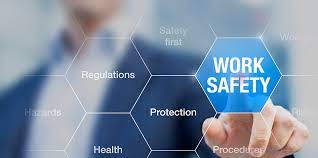When you show up to work in the morning, you expect to make some money and return home in one piece. You might also anticipate you’ll finish the day worn out, but not getting hurt.
To avoid a potential on-the-job injury, however, you may need to change some of your habits.

Five Ways to Avoid Workplace Injuries
Some industries and workplace environments obviously entail greater risk than others. But it doesn’t matter whether you work on a construction site with heavy machinery or in an office setting with a computer terminal in a cubicle, you always face some level of risk.
Here are five specific ways you can reduce your chances of getting hurt on the job.
- Wear Proper Safety Equipment (if Needed)
If you work in an environment where heavy machinery is operated, and/or there’s a risk of being exposed to hazardous conditions or materials, then you should make sure you always wear the proper safety equipment. Yes, it may feel uncomfortable and unnecessary, but it still could prevent serious injury.
On a related note, don’t be afraid to confront your employer or direct supervisor if you believe you don’t have the protective equipment necessary to remain safe in your work environment. This may include any or all of the following: back brace/support belt, gloves, goggles, face protection, hard hats, earplugs, and safety boots.
- Beware of the Mundane
Injuries don’t always happen as a result of massive missteps or significant unforeseen events. In many cases, injuries occur during mundane tasks. According to one study, the three most common workplace injuries are:
- Overexertion (28 percent). This includes injuries from pushing, lifting, holding, pulling, throwing, or carrying.
- Same level fall (16.9 percent). As the name suggests, these are falls that occur all on a single level. Injuries typically occur due to a slip or trip.
- Bodily reaction (11.4 percent). This consists of injuries that result from climbing, bending, standing, reaching, sitting, or slipping, or tripping without an actual fall.
Over 56 percent of all workplace injuries qualify under one of these three categories. Thus, if you want to reduce your risk of being hurt on the job, you have to get serious about anticipating these situations.
One way to avoid overexertion and bodily reaction injuries is to stretch and strengthen core muscles and important joints such as shoulders, elbows, wrists, lower back, hips, knees, and ankles by using biomechanical exercises.
- Ask When Uncertain
Many injuries occur when an employee was uncertain about how to perform a certain task, but failed to seek guidance for fear of looking weak or inadequate. The only way to avoid this condition for injury is to push your ego to the side and initiate open dialogue.
Make a habit of always asking. If it’s something new, confusing, or different, talk about it with your coworkers and superiors.
Say something like, “Hey, these instructions sound a little different than what we typically do. I just want to double-check and make sure that I understand you correctly. Are you asking us to….”
It might feel uncomfortable to request clarity the first couple of times – particularly if it’s not something you’ve done often before, and others are not used to doing it – but eventually it can become part of the workplace culture.
- Take Training Seriously
Training isn’t something you should greet with an eye roll. It’s a valuable resource that can be leveraged to improve your performance and safety.
Take it seriously (and encourage those around you to do the same). Treat each training program as an opportunity to reduce personal risk, improve skills, and grow as a person. That might sound dramatic, but it’s the best way to view it.
- Slow Down and Change it Up
Any time a process or routine becomes second nature, you risk “falling asleep” at the wheel. Once you no longer have to think about a task, your brain may kick into a lower gear and you become less conscientious.
To avoid these situations – which are ripe for missteps and injury – force yourself to slow down and, if possible, change up how you approach various procedures.
Look Out for Number One
Any employer worth their salt will have an explicit set of safety rules and procedures in place to prevent their employees from getting hurt. But in all honesty, these guidelines typically exist to save their rear end – not yours.
If you honestly wish to avoid getting injured at work, you have to look out for yourself. That means making sound and proactive decisions that prioritize your physical and emotional well-being. This article should give you a sense of where to start.
Leave a Reply